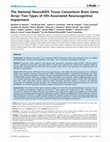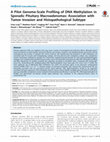Papers by Deborah Commins

Molecular Diagnosis & Therapy
The neurological complications of AIDS (NeuroAIDS) include neurocognitive impairment and HIV-asso... more The neurological complications of AIDS (NeuroAIDS) include neurocognitive impairment and HIV-associated dementia (HAD; also known as AIDS dementia and HIV encephalopathy). HAD is the most significant and devastating central nervous system (CNS) complications associated with HIV infection. Despite recent advances in our knowledge of the clinical features, pathogenesis, and neurobiological aspects of HAD, it remains a formidable scientific and therapeutic challenge. An understanding of the mechanisms of HIV neuroinvasion, CNS proliferation, and HAD pathogenesis provide a basis for the interpretation of the diagnostic features of HAD and its milder form, HIV-associated minor cognitive/motor disorder (MCMD). Current diagnostic strategies are associated with significant limitations, but it is hoped that the use of biomarkers may assist researchers and clinicians in predicting the onset of the disease process and in evaluating the effects of new therapies.
British journal of cancer, Jan 20, 2013
Meningiomas are the most common primary intracranial tumours, with ∼3% meeting current histopatho... more Meningiomas are the most common primary intracranial tumours, with ∼3% meeting current histopathologic criteria for malignancy. In this study, we explored the transcriptome of meningiomas using RNA-Seq. Inversion-mediated fusions between two adjacent genes, NAB2 and STAT6, were detected in one malignant tumour, creating two novel in-frame transcripts that were validated by RT-PCR and Sanger sequencing. Gene fusions of NAB2-STAT6 were recently implicated in the pathogenesis of solitary fibrous tumours; our study suggested that similar fusions may also have a role in a malignant meningioma with unusual histopathologic features.

PURPOSE The apparent diffusion coefficient (ADC) determined from diffusion tensor (DTI) MR imagin... more PURPOSE The apparent diffusion coefficient (ADC) determined from diffusion tensor (DTI) MR imaging can give an impression of the extravascular-extracellular space (EES) and has been shown to be inversely correlated with tumor cell density. Parametric maps such as the EES fraction (ve) derived from dynamic contrast enhanced (DCE) MRI also characterize EES. The purpose of this study was to determine if there is a correlation between ADC and DCE metrics such as ve, blood-brain barrier transfer constant (Ktrans), Kep (Ktrans/ve), and fractional plasma volume (vp) for gliomas, cerebral lymphomas and meningiomas. Figure 1 demonstrates ADC and ve parametric maps for a glioma. METHOD AND MATERIALS 18 gliomas (grade I-IV), 2 lymphomas and 5 meningiomas were retrospectively evaluated. DTI and DCE images were acquired during the same MRI exam. DCE-MRI images were postprocessed in CADvue. Metrics extracted from DCE MRI were: ve, vp, Ktrans, and Kep. ADC maps were generated by the MR scanner. DC...
The Open Virology Journal, 2008
Cocaine opens the blood-brain barrier by deregulating transcription of target genes. Here we show... more Cocaine opens the blood-brain barrier by deregulating transcription of target genes. Here we show that cocaine at blood concentrations in drug abusers disrupts endothelial cell junctions in parallel with signaling by phosphorylation of extracellular signal-regulated kinase, myristoylated alanine-rich C kinase and myosin light chain. Cocaine effects may be important in vivo since the neurons of drug abusing patients with HIV-1 associated dementia displayed gp120, p24 and Nef.

Neurosurgical focus, 2015
Ectopic pituitary adenomas are exceedingly rare entities that are often misdiagnosed. The resulti... more Ectopic pituitary adenomas are exceedingly rare entities that are often misdiagnosed. The resulting delay in diagnosis may be particularly concerning in the case of Cushing syndrome caused by an ectopic adrenocorticotropic hormone (ACTH)-secreting pituitary adenoma. Although the total resection of ectopic adenomas results in rapid and durable remission, persistent Cushing syndrome is often associated with permanently damaging invasive procedures and significantly higher risk of mortality. The authors report the case of a 48-year-old man with ACTH-dependent Cushing syndrome. On the morning before surgery, his serum cortisol measured 51 μg/dl, his ACTH level was 195.7 pg/ml, and his urinary free cortisol level was 2109 μg/day. Serum cortisol was not suppressed with the administration of high-dose dexamethasone. Imaging showed separate masses in both the sphenoid sinus and the pituitary gland, complicating the diagnostic process and requiring pathological assessment of both masses. No ...

Bioinformation, 2011
The human immunodeficiency virus type-1 (HIV-1) gp160 (gp120-gp41 complex) trimer envelope (ENV) ... more The human immunodeficiency virus type-1 (HIV-1) gp160 (gp120-gp41 complex) trimer envelope (ENV) protein is a potential vaccine candidate for HIV/AIDS. HIV-1 vaccine development has been problematic and charge polarity as well as sequence variation across clades may relate to the difficulties. Further obstacles are caused by sequence variation between blood and brain-derived sequences, since the brain is a separate compartment for HIV-1 infection. We utilize a threedimensional residue measure of solvent exposure, accessible surface area (ASA), which shows that major segments of gp120 and gp41 known structures are solvent exposed across clades. We demonstrate a large percent sequence polarity for solvent exposed residues in gp120 and gp41. The range of sequence polarity varies across clades, blood, and brain from different geographical locations. Regression analysis shows that blood and brain gp120 and gp41 percent sequence polarity range correlate with mean Shannon entropy. These re...
Bioinformation, 2011
A number of genes are involved in various neuropsychiatric disorders. A comprehensive compilation... more A number of genes are involved in various neuropsychiatric disorders. A comprehensive compilation of these genes is important for a better understanding of these diseases. We report an online file that lists genes by chromosome number and location. This is useful for the rapid examination of chromosome bands for genes involved in these diseases. This is not an exhaustive list and does not include single nucleotide polymorphism (SNP) results for genes that are currently being examined by genome wide association studies (GWAS) and other molecular methodologies. The database is available for free at http://www.bioinformation.net/007/paul.xls.

PloS one, 2012
The National NeuroAIDS Tissue Consortium (NNTC) performed a brain gene expression array to elucid... more The National NeuroAIDS Tissue Consortium (NNTC) performed a brain gene expression array to elucidate pathophysiologies of Human Immunodeficiency Virus type 1 (HIV-1)-associated neurocognitive disorders. Twenty-four human subjects in four groups were examined A) Uninfected controls; B) HIV-1 infected subjects with no substantial neurocognitive impairment (NCI); C) Infected with substantial NCI without HIV encephalitis (HIVE); D) Infected with substantial NCI and HIVE. RNA from neocortex, white matter, and neostriatum was processed with the Affymetrix® array platform. With HIVE the HIV-1 RNA load in brain tissue was three log(10) units higher than other groups and over 1,900 gene probes were regulated. Interferon response genes (IFRGs), antigen presentation, complement components and CD163 antigen were strongly upregulated. In frontal neocortex downregulated neuronal pathways strongly dominated in HIVE, including GABA receptors, glutamate signaling, synaptic potentiation, axon guidanc...

Journal of neurological surgery reports, 2014
Introduction Fusarium spp is an omnipresent fungal species that may lead to fatal infections in i... more Introduction Fusarium spp is an omnipresent fungal species that may lead to fatal infections in immunocompromised populations. Spontaneous intracranial infection by Fusarium spp in immunocompetent individuals is exceedingly rare. Case Report An immunocompetent 33-year-old Hispanic woman presented with persistent headaches and was found to have a contrast-enhancing mass in the left petrous apex and prepontine cistern. She underwent a subsequent craniotomy for biopsy and partial resection that revealed a Fusarium abscess. She had a left transient partial oculomotor palsy following the operation that resolved over the next few weeks. She was treated with long-term intravenous antifungal therapy and remained at her neurologic baseline 18 months following the intervention. Discussion To our knowledge, this is the first reported case of Fusarium spp brain abscess in an immunocompetent patient. Treatment options include surgical intervention and various antifungal medications. Conclusion T...

Bioinformation, 2011
We analyzed RNA gene expression in neurons from 16 cases in four categories, HIV associated demen... more We analyzed RNA gene expression in neurons from 16 cases in four categories, HIV associated dementia with HIV encephalitis (HAD/HIVE), HAD alone, HIVE alone, and HIV-1-positive (HIV+)with neither HAD nor HIVE. We produced the neurons by laser capture microdissection (LCM) from cryopreserved globus pallidus. Of 55,000 gene fragments analyzed, expression of 197 genes was identified with significance (p = 0.005).We examined each gene for its position in the human genome and found a non-stochastic occurrence for only seven genes, on chromosome 22. Six of the seven genes were identified, CSNK1E (casein kinase 1 epsilon), DGCR8 (Di George syndrome critical region 8), GGA1 (Golgi associated gamma adaptin ear containing ARF binding protein 1), MAPK11 (mitogen activated protein kinase 11), SMCR7L (Smith-Magenis syndrome chromosome region candidate 7-like), andTBC1D22A (TBC1 domain family member 22A). Six genes (CSNK1E, DGCR8, GGA1, MAPK11, SMCR7L, and one unidentified gene) had similar expre...

Spine, 2001
The first reported case of multiple intradural, extramedullary spinal metastasis from sinonasal u... more The first reported case of multiple intradural, extramedullary spinal metastasis from sinonasal undifferentiated carcinoma is presented. To elucidate the mechanisms by which metastatic disease invades the spinal axis, and to discuss the possibility of spinal drop metastasis from head and neck tumors that invade the dura. Sinonasal undifferentiated carcinoma is a rare yet aggressive neoplasm of the upper airways and anterior skull base. This neoplasm is known to invade the cranial vault and brain locally. However, it has not previously been reported to seed the cerebrospinal fluid or result in drop metastasis. Such drop metastasis may result in significant neurologic deficit if not diagnosed and treated in a timely manner. This report is based on a single patient treated by a multidisciplinary team from the departments of neurosurgery, otolaryngology, and radiation oncology at the University of Southern California School of Medicine. This patient initially underwent resection and local radiation therapy for sinonasal undifferentiated carcinoma of the anterior skull base. At the time of surgery, the tumor was noted to violate the dura and arachnoid along the subfrontal plane. At 11/2 years after the initial treatment, a bandlike distribution developed at T2 as well as paresthesias and numbness below that level. Imaging of the spine showed an intradural, extramedullary tumor at T2 consistent with a schwannoma or meningioma. The patient underwent a laminectomy and tumor resection, which showed poorly differentiated sinonasal carcinoma. Local radiation therapy was administered, and the patient experienced complete recovery of neurologic function. Bilateral leg pain and weakness developed 14 months later. Magnetic resonance imaging of the spine showed a new intradural, extramedullary lesion at T12, remote from the first lesion. This second metastasis was managed with surgical resection and adjuvant radiation therapy. This is the first reported case of a sinonasal carcinoma leading to intradural extramedullary metastasis. The primary tumor likely seeded the cerebrospinal fluid, thus resulting in drop metastasis. Patients with sinonasal undifferentiated carcinoma that invades the dura should be monitored closely for evidence of metastasis before symptoms develop.

PLoS ONE, 2014
Pituitary adenomas (PAs) are neoplasms that may cause a variety of neurological and endocrine eff... more Pituitary adenomas (PAs) are neoplasms that may cause a variety of neurological and endocrine effects. Although known causal contributors include heredity, hormonal influence and somatic mutations, the pathophysiologic mechanisms driving tumorigenesis and invasion of sporadic PAs remain unknown. We hypothesized that alterations in DNA methylation are associated with PA invasion and histopathology subtype, and that genome-scale methylation analysis may complement current classification methods for sporadic PAs. Twenty-four surgically-resected sporadic PAs with varying histopathological subtypes were assigned dichotomized Knosp invasion scores and examined using genome-wide DNA methylation profiling and RNA sequencing. PA samples clustered into subgroups according to functional status. Compared with hormonallyactive PAs, nonfunctional PAs exhibited global DNA hypermethylation (mean beta-value 0.47 versus 0.42, P = 0.005); the most significant site of differential DNA methylation was within the promoter region of the potassium voltage-gated channel KCNAB2 (FDR = 5.11610 210 ). Pathway analysis of promoter-associated CpGs showed that nonfunctional PAs are potentially associated with the ion-channel activity signal pathway. DNA hypermethylation tended to be negatively correlated with gene expression. DNA methylation analysis may be used to identify candidate genes involved in PA function and may potentially complement current standard immunostaining classification in sporadic PAs. DNA hypermethylation of KCNAB2 and downstream ion-channel activity signal pathways may contribute to the endocrine-inactive status of nonfunctional PAs.

Neurosurgical FOCUS, 2007
The histological appearance of a meningioma is an important predictor of tumor behavior and is fr... more The histological appearance of a meningioma is an important predictor of tumor behavior and is frequently a factor in decisions concerning therapy. The relationship between histological features and prognosis is formalized in grading schemes such as those published by the World Health Organization (WHO), most recently in 2007. Although the latest edition is an improvement over previous grading schemes, the WHO scheme still fails to fully address a variety of important issues regarding the relationship between meningioma histological characteristics and behavior. In particular, routine histological examination fails to identify the subset of Grade I tumors that behave aggressively. Because of this, many additional prognostic markers that require immunohistochemical, cytogenetic, or molecular techniques to evaluate are under investigation. Only one, immunohistochemistry for the proliferation marker, Ki 67 (MIB-1), is used routinely and it has only limited utility. It is hoped that an understanding of the genetic changes that underlie tumor progression will improve healthcare professionals' ability to predict the behavior of meningiomas.
Molecular Diagnosis & Therapy, 2009

Molecular Diagnosis & Therapy, 2008
ABSTRACT The neurological complications of AIDS (NeuroAIDS) include neurocognitive impairment and... more ABSTRACT The neurological complications of AIDS (NeuroAIDS) include neurocognitive impairment and HIV-associated dementia (HAD; also known as AIDS dementia and HIV encephalopathy). HAD is the most significant and devastating central nervous system (CNS) complications associated with HIV infection. Despite recent advances in our knowledge of the clinical features, pathogenesis, and neurobiological aspects of HAD, it remains a formidable scientific and therapeutic challenge. An understanding of the mechanisms of HIV neuroinvasion, CNS proliferation, and HAD pathogenesis provide a basis for the interpretation of the diagnostic features of HAD and its milder form, HIV-associated minor cognitive/motor disorder (MCMD). Current diagnostic strategies are associated with significant limitations, but it is hoped that the use of biomarkers may assist researchers and clinicians in predicting the onset of the disease process and in evaluating the effects of new therapies.

Journal of Neurovirology, 2009
Human immunodeficiency virus type 1 (HIV-1) invades the central nervous system (CNS) shortly afte... more Human immunodeficiency virus type 1 (HIV-1) invades the central nervous system (CNS) shortly after infection and becomes localized in varying concentrations in different brain regions, the most vulnerable is the basal ganglia (BG). It is hypothesized that HIV-1-mediated neuropathogenesis involves degeneration of dopaminergic neurons in the substantia nigra and the loss of dopaminergic terminals in the BG, leading to deficits in the central dopaminergic activity, resulting in progressive impairment of neurocognitive and motor functions. In the era of highly active antiretroviral therapy (HAART), although the incidence of HIV-associated dementia (HAD) has decreased, the neurocognitive and neuropsychological deficits continue to persist after HAART. In this study, We investigated the impact of HIV-1 on dopaminergic activity with respect to concentrations of dopamine (DA) and homovanillic acid (HVA) in different regions of postmortem human brains of HIV-1-negative and HIV-1+ individuals and their relationship to neurocognitive impairment. We found that in HIV-1+ as well as HIV-negative cases, dopamine and HVA concentrations in ranged widely in different brain regions. In HIV-negative brain regions, the highest concentration of DA was found in putamen, caudate, substantia nigra, and the basal ganglia. In HIV-1+ cases, there was a significant decrease in DA levels in caudate nucleus, putamen, globus pallidus, and substantia nigra compared to that in HIV-negative cases. In HIV-1+ cases, a strong correlation was found between DA levels in substantia nigra and other brain regions. Concentration of HVA in HIV-negative cases was also highest in the regions containing high dopamine levels. However, no significant decrease in regional HVA levels was found in HIV-1+ cases. HIV-1 RNA load (nondetectable [ND] to log10 6.9 copies/g tissue) also ranged widely in the same brain regions of HIV-1+ cases. Interestingly, the brain regions having the highest HIV-1 RNA had the maximum decrease in DA levels. Age, gender, ethnicity, and postmortem interval were not correlated with decrease in DA levels. Profile of DA, HVA, and HIV-1 RNA levels in the brain regions of HIV-1+ individuals treated with HAART was similar to those not treated with HAART. A majority of HIV-1+ individuals had variable degrees of neurocognitive impairments, but no specific relationship was found between the regional DA content and severity of neurocognitive deficits. These findings suggest widespread deficits in dopamine in different brain regions of HIV-1-infected cases, and that these deficits may be the results of HIV-1-induced neurodegeneration in the subcortical regions of human brain.
Journal of Neuropathology and Experimental Neurology, 2007

Journal of Infectious Diseases, 1995
The objective of this study was to correlate cytomegalovirus (CMV) DNA levels in the cerebrospina... more The objective of this study was to correlate cytomegalovirus (CMV) DNA levels in the cerebrospinal fluid (CSF) of subjects with AIDS with clinical and pathologic findings attributable to CMV infection of the central nervous system (CNS). CMV polymerase chain reaction (PCR) was done on serial dilutions of CSF samples from 24 AIDS patients with autopsy-proven CNS disorders. CMV DNA was detected in CSF from 12 of 13 subjects with evidence of CMV infection of the brain or spinal cord but in none of 11 subjects without autopsy evidence of CMV CNS infection. Subjects whose CSF contained > 10(3) CMV DNA molecules/8 microL of CSF had severe CMV CNS disease (e.g., ventriculoencephalitis). PCR appears to be more useful than clinical and neuroradiologic findings for documenting CMV infection of the CNS in patients with AIDS. Quantitation of CMV DNA in CSF shows promise for evaluation of the extent of involvement.

Journal of Clinical and Experimental Neuropsychology, 2008
Central nervous system opportunistic infections (CNS-OI) are a significant cause of morbidity and... more Central nervous system opportunistic infections (CNS-OI) are a significant cause of morbidity and mortality in AIDS. While current interventions are increasingly successful in treating CNS-OI, little information exists regarding long-term behavioral outcomes among survivors. In this exploratory study we examined neurocognitive data among three groups of adults with different AIDS-related CNS-OI: 15 with past cryptococcal meningitis (CM), 8 with toxoplasmosis encephalitis (TE), and 8 with progressive multifocal leukoencephalopathy (PML). A group of 61 individuals with AIDS, but without CNS-OI, was used as a comparison group. A battery of standardized neuropsychological tests assessing a variety of cognitive domains was administered upon entry. Results indicate that individuals with a history of CNS-OI were most impaired on measures of cognitive and psychomotor speed relative to the HIV+ comparison group. Among the CNS-OI groups, individuals with history of TE had the most severe and varied deficits. The results are discussed in relation to what is known about the neuropathological consequences of the various CNS-OIs. While this is the first systematic group study of residual CNS-OI effects on neurocognitive function, future studies employing more participants, perhaps focusing on specific CNS-OIs, will further characterize the long-term outcomes in AIDS-related CNS-OI.








Uploads
Papers by Deborah Commins